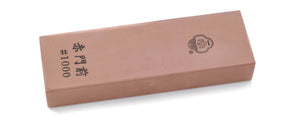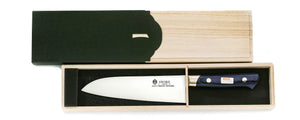
Features
- Blade: White steel No.2; Standard steel for Japanese kitchen knives and is most commonly used by professionals.
- Honyaki: The process of making knives that results in high hardness and hign edge retention.
| Product number | Actual Blade Length (mm) | Full Length (mm) | Total Weight (g) |
|---|---|---|---|
| 1s3-e240 | 230 | 380 | 170 |
| 1s3-e270 | 260 | 415 | 200 |
| 1s3-e300 | 290 | 450 | 225 |
| Blade | Material Name | Handle |
|---|---|---|

Single Edged |
White Steel #2 | Octagonal Ebony |

Yanagiba (Sashimi Knife)
Yanagiba knives are mainly used for cutting Sashimi. The sharpness and edge geometry is of the utmost important with a Yanagiba, as a dull knife will damage the delicate fibres of the fish. The blade is long, slender, thin and sharp for cutting sashimi in one stroke. In addition to cutting sashimi, this knife is also used for pulling the skin. Professionals use long Yanagiba knives with blades around 300mm. For home use, Yanagiba knives with a blade of around 210mm are popular.

White Steel #2
Carbon Steel
White steel #2 is the standard steel for Japanese kitchen knives and is most commonly used by professionals. It's a high purity steel,characterized by its sharpness and cutting performance.
In comparison to White Steel #1, White Steel #2 is softer so it is slightly more durable and less likely to chip.
This is the first series of knives that professional chefs and those who want to use a slightly better knife for home use often have.
*NOTE: Carbon Steel is susceptible to rust if it is not properly cared for. Please clean and dry the blade regularly during use and after use.

Ebony octagonal handle
Handle
Ebony octagonal handle
We use an ebony handle that brings high durability and balance to the knives.
Because of its beauty and robustness and the difficulty of processing
It is popular as the most exclusive wood and is used in Buddhist altars.
The unique grain of the wood will naturally become more comfortable in your hand as you use it.
Honyaki
Forging Process
The Honyaki method produces some of the highest grade kitchen knives in the world. It is an extremely difficult and laborious process, reminiscent of traditional Japanese sword making techniques, there are few craftsmen in Japan today that are capable of producing blades this way due to the high level of experience, skill and physical dexterity required. The blades made from the Honyaku method will often have a distinct "Hamon" or edge line in the blade, they are extremely sharp but easily chipped due to their high hardness, so require care when using.

Optional Engraving
Optional Engraving Service
Sakai Ichimonji provides complimentary engraving using either Japanese Kanji or English Alphabet. Please specify your preference. For details, please visit here
A knife store that has supported the history of knives and food culture in Japan.
It has been 600 years since the birth of swordmaking in the Sakai region of Japan. Sakai Ichimonji Mitsuhide's and it's craftsmen continue to build on that legacy by producing the finest blades in Japan.
This is where the culture of completing a dish of sashimi by "just cutting" and the culture of expressing sharpness as "taste" was born.
For 70 years, we have been connecting the spirit of Sakai's craftsmen with the passion of chefs in Osaka's kitchen equipment shopping district, known as the kitchen of Japan.
We are very happy that our knives can be used by people all over the world.
Precautions
After use, wash off any dirt and wipe thoroughly with a dry cloth to remove any moisture. This product is not for use with frozen foods.This product is handmade, so each piece will be different. Please use the weight and length listed as a guide. Each material is natural and may vary in color. It is not the same as the picture.We take great care with our inventory, but in the unlikely event that we are out of stock, we will contact you by email to let you know.









































